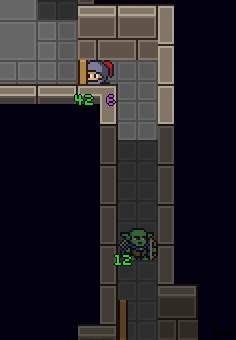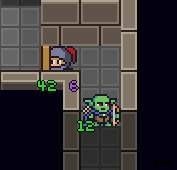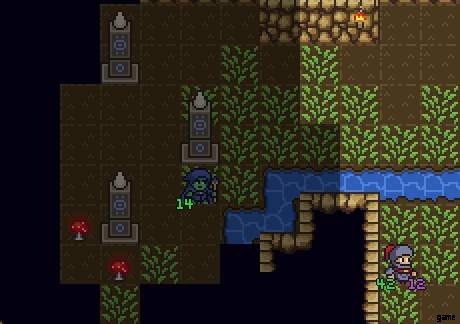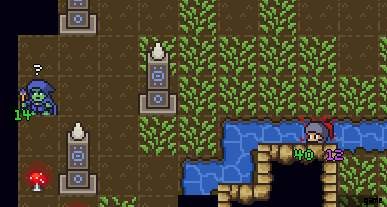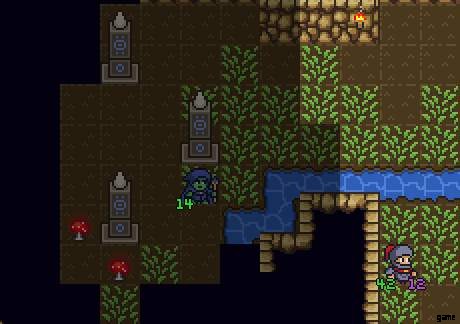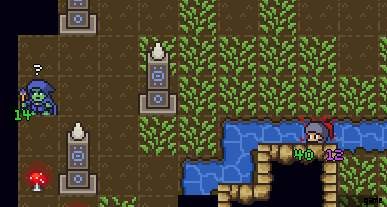Rogue Fable III – 決定的な戦術ガイド
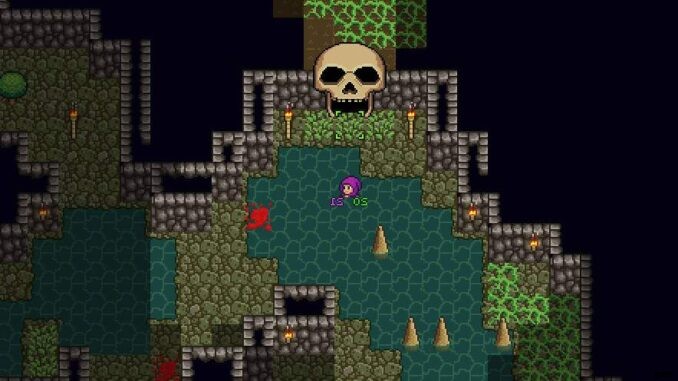
伝統的なローグライク サバイバルの基礎を学び、どんなスタートでも勝つことができます。
戦術ガイド
序文
これは Rogue Fable III の戦術ガイドであり、不公平な戦いを公正な戦いに変えるために、本のすべてのトリックを使用して、これや他の伝統的なローグライク ゲームをプレイするための考え方を養うのに役立ちます。特に、これは戦略ガイドでもビルドガイドでもありません。特定の種族やクラスをどのようにプレイすべきかは教えてくれません。それは比較的自明であり、実際に自分で理解するのは楽しいです.このガイドは、ローグライクゲームをプレイする際の「見えない」側面に焦点を当てています.考えもしなかったし、ゲームは決してほのめかしません。
Rogue Fable III ではどのシードも獲得できるとよく言われます。自分で作る以外に勝てない状況はありません。最高の RF3 プレイヤーが誰であるかはわかりませんが、これまでで最高の Nethack 連勝であることは知っています。は 61 で、これまでで最高のダンジョン クロール ストーン スープの連勝は 62 です。このレベルの規律のほんの一部でも、自分の勝利を得ることができます。
このゲームの目標は、最初に勝つこと、次にすべてのクラスで勝つこと、次に 3 連勝を達成すること、次にデイリー チャレンジで 3 連勝を達成することです。その後、自分を RF3 マスターと見なすことができます。学んだことを他の伝統的なローグライクゲームに取り入れることを検討する必要があります!始めましょう。
ルール 0
タクティカル ローグライクのルール 0 は次のとおりです。「デフォルトでは、敵に向かって歩くのは間違いです」。このルールが適用されるさまざまな状況と戦術、および適用されない例外について調べてみましょう。
- 先制攻撃: 些細なことですが、このジャンルの新しいプレイヤーは考えないかもしれません。近接敵の隣に足を踏み入れると、最初に攻撃を受けます。しかし、じっとしていると、敵があなたの隣に足を踏み入れ、最初のヒットを得る.同様の理由で、遠距離の敵にも最初のヒットを与えるようにしてください。
- コーナーピーク: あなたから数タイル離れた遠距離の敵を発見した場合、それに向かって歩くと数回ヒットしますが、固い壁の周りを歩いて視線を壊すか(以降、LoS)、敵の後ろに足を踏み入れて射線(以降、LoF)を壊します。障害物は、それがあなたに来ることを余儀なくされます.
ただし、キッティングの敵は、攻撃できる最も遠いタイルに移動するほど賢いので、すべてのコーナーが同じようにうまく機能するとは限りません. 、そしてゴブリンストームメイジは私を見て、ここにオーブオブストームを召喚することができました!
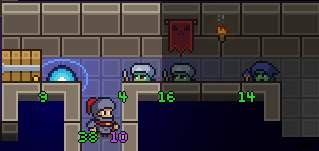
- LoS Edge Kiting: 最大範囲で敵を攻撃した場合 ('?' ではなく '???' が必要です – 直角方向または 6,3 対角線で正確に 7 タイル離れていることを試してください)、逃げ始めると、範囲外の各ターンが開始されます。あなたのLoSとあなたに向かって歩かなければなりません。これにより、射手でさえ有利な地形にカイトできます。ただし、水平なレイアウトで常にそれらを遠ざけることができることを確認し、対角線が直交する動きよりも「遠くに」移動することを確認し、最小限のダメージで射程内に入る計画を立ててください。カイトを終えたときに撮影します。 (さらに、多くの遠距離ユニットの最大射程は 7.5 未満です。デフォルトでは、エレメンタル/スタチューは 7、アーチャーは 5、メイジは 4 です! これにより、LoS で偶数タイルを使用して凧を揚げることができます。)

- 斜めダイビング: RF3 の LoS と射程は円なので、斜めのパスを取ると、敵からの接近/後退が速くなります。特に;敵に直角に接近すると、敵は 7 タイルの間 LoS になり、7 タイルの検出範囲になります (アプローチを 1 または 2 タイル高く開始した場合は 6)。一方、対角線では、5 タイルの LoS とわずか 4 タイルの検出範囲になります。
- チョークポイント: 一度にあなたに射線を向けさせる敵の数が多ければ多いほど、あなたの立場は悪化します。隅または 1 つのタイルの廊下に退却すると、表面積が制限され、一度に 1 つずつ対処できます。
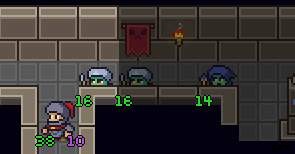
- 未知なるものを恐れる: そうでないことがわかるまでは、すべての未踏のタイルが敵でいっぱいであると想定する必要があります。敵を退却させたりおびき寄せたりする場合は、敵を階段や有用な地形に引き寄せてください。未踏の領域に出くわして、より多くの敵を戦闘に巻き込む可能性はありません。また、敵のシャウトはシャウターから 6 タイル以内の他の敵を攻撃しますが、10.5 タイル以上離れた敵はこの方法で攻撃することはできず、LoS の外のシャウトは 3 タイルに半分になります。この最初のゴブリン ストーム メイジを攻撃し、私の LoS から移動させてこちらに移動させることで、他のゴブリン ストーム メイジの友人は最初のシャウトからかろうじて 3 タイル離れたところにいて、気付かれることはありません!これはパック分割 (Shout Dampening Variant) です。
- ピラー ダンシング: 敵から逃げる必要があり、スペースを使い果たしたくない場合は、1 つのタイルの柱または閉じたループを使用できます。あなたと敵は同じ速度で移動するため、敵が追いつくことはなく、リソース/クールダウンを自由に再生できます。たとえば、ウォリアーはじっとしていて近接敵に近接攻撃を行うべきではありませんが、Shields Up がクールダウン中のときはいつでも退却してください。ただし、敵が遠距離にいる場合は、タイルの柱を 1 つ使用する必要があります。敵が常に LoS から外れている場合、おまけとして、これに加えて敵の攻撃を解除できます。また、閉ループの 50% マークを超えると、敵が反対方向からあなたを追いかけ始めるため、側面攻撃を受ける可能性があることに注意してください。 (でも、わざと使ってるかも…?)
- ステアダンス: 階段を上ると、敵が行動できるターンが1回経過し、そのターン後にレベルが遷移します。現在あなたに隣接している敵が続きます(可能であれば、敵が1タイル離れたときに階段を上ってください)。置き去りにされたすべての敵は、時間が経過することなく、攻撃を解除してその場で待機します。彼らはHPを再生したり、ステータス効果/雲をすり減らしたりしません!そのため、ステアダンシングには 3 つの主なモードがあります。階段を上ってすべてのリソースを再生し、戻って戦闘を続ける「ピーク」。一度に1つまたはいくつかを別のレベルに引っ張って、敵のパックを分割する「引っ張る」。今は戦いたくないモンスターをクリアレベルに移動し、それをジュークして、後まで無視できる場所にデアグロする「パーキング」。 (TODO:穴に落ちるとはどういうことですか? 安全であれば、階段の代わりとして使用できます)
- 有利な地形を使用: 見つけた場所から敵をおびき寄せながら、有益な地形の特徴に誘い込むことを検討してください。不安定な地形は、物理攻撃が 1.5 倍のダメージを与え、繰り返し使用できます。可燃物は、火の攻撃に範囲ダメージを追加できます。ウォーター リードとショック リードは、稲妻に対して同様の効果を発揮します (不安定であることも忘れないでください!)。雲は LoS をブロックし、敵があなたを見るのを防ぐことができますが、あなたはそれらを見ることができます (そして水を使って自分のものにすることができます!)。ファイア シュルームやその他の被破壊物は痛烈に爆発します。噴水は戦闘中のリソースを提供します。ピットはノックインした敵を即死させ、逃げ道を与えます。柱、コーナー、ループは、LoS を壊したり、撤退の選択肢を与えたりする可能性があります。敵は移動を選択する際に危険な地形を考慮しません!
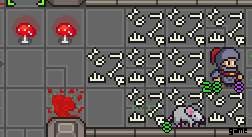
- チャンプブロッキング: 敵はお互いの LoF をブロックします。したがって、それほど怖くない敵は、より恐ろしい敵があなたを撃つことをブロックできます。意図的に操作したり、生かしておくことさえできます。あなたと遠距離の敵の間に近接の敵を置いておくと、遠距離の敵を無期限にカイトできます!チャンプブロッカーとしてゲーム全体を通してネズミをカイトするのを止めるものは何もありませんが、それはばかげているかもしれません. (また、ラットは時々ランダムに動くので注意してください。) また、チャンプブロックされたアーチャーがチャンプブロッカーを撃つこともありますが、それをトリガーする方法がわかりません。
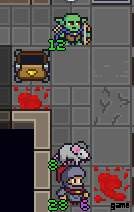
- パック分割 (De-Aggro Cheese Variant): あなたから可能な限り最大の距離 (直交する 7 タイル) で敵を攻撃し、20 ターン連続して敵を LoS から遠ざけると、攻撃が解除されます (マップとミニマップから消えます)。他のすべての敵もそのシャウトを攻撃します。この時点で、彼らは動きを止めて静止し、パックがどのように広がるかに応じて、どちらも未踏の領域からはるかに離れており(増援が来ないことを知って安全に戦うことができます)、パックの攻撃が少なくなります.
ルール 0 の例外
- この遠隔ユニットを近づけることができません: 地形が単に不利な場合、またはすでに悪い位置にいる場合は、そこに近づくことを余儀なくされる可能性があります.広いオープンエリアと真の壁がないレベルは、これを引き起こす可能性があります.特に、ユニットが「賢く」行動し、LoS で最も遠いタイルに移動している場合、最小射程は 3 です。近くに他の敵がいなければ、無害になる可能性があります。
- 動かないユニット: スポナー、彫像、スイマーは、選択したレベルの一部にカイトすることはできません.彼らを殺して無視したい場合は、彼らに近づく必要があるかもしれません。オプションを改善するために、最初にレベルの周囲の部分をクリアすることをお勧めします。
- 速い敵、遅いプレイヤー: 敵があなたよりも速く動く場合、あなたができるカイトは限られています。時間内に到達できる最も有利な位置を把握します。あなたがより遅く、それが射撃の敵である場合、すぐに交戦するよりも良いプレーはないかもしれません. (逆に、敵ユニットよりも速いときはいつでも - 近接攻撃の場合は、リソースを消費することなく無限の自由な動きを得ることができます!)
ローグライク メンタリティ
伝統的なローグライク ゲームをプレイする目的は、最強のキャラクターを作ることでも、プレイスタイルのファンタジーを実現することでも、十分長くプレイするだけで最終的に勝つことでもありません。目標は勝つこと、そしてできるだけ頻繁に勝つことです。危険な状況に陥り、かろうじて生き残った場合のボーナスポイントはありません。計算を誤って最初からやり直さなければならない可能性があるだけです。すぐに考えたりプレイしたりするプレッシャーはありません。ゲームはターン制です。すべての消耗品を使用したり、特定の戦略を控えたりせずに勝っても、報酬はありません。これらの原則は、次の経験則につながります:
- 消耗品を早めに使用する: Some consumables are designed as panic buttons (like the potion of healing) – others may have greater use if employed before the tide of the battle turns against you. A potion of power boosts your DPS, but you can’t later decide you wanted to use it at the start of the fight. A well timed javelin or wand may kill a troublesome enemy before it can snowball out of control. A wand of blades zap may relieve pressure and give you several free turns when you can make them most count. And so on. As a result, the skill of risk assessment, determining how hard a fight will be before you begin it, is an important one to cultivate. But even more to the point, ‘this is the end of the game, I won’t ever have another chance to use them’, or ‘this is a boss fight, it’s going to be hard’ are also simple and useful pattern recognition heuristics.
- Use Consumables Often: Rogue Fable 3 is a short game – it can be beaten in 2 hours playing at a typical pace. There’s not that much game for you to save consumables for, and no consolation price for dying with a potion of healing still in your backpack. Use them or lose them.
- Risk Assessment: RF3 has a useful feature – you can mouse over each enemy and see the maximum possible damage they can deal. This lets you, for example, calculate the worst possible case scenario for a turn, as long as you also take into account surprises (hazardous terrain, damage shields, the 1.5x damage multiplier for being constricted, etc). How many turns you’ll die in if you sit still and do nothing is an important metric to always be aware of – if you’re going to die right now, you need to stop and think of what your highest probability out is. If you’re going to die in two turns, it’s now your job to play smartly and use consumables so you don’t fall into the previous category. Even dying in three or more turns is a situation to take seriously. And you should always play more conservatively than how much damage you can take implies; you may not instantly be able to bail yourself out, you may have missed an interaction or non-damage effect an enemy can do, and given that this is a game where a damageless run is possible, you should take any and all opportunities to minimize how much damage your run takes.
- Cool and Level Headed: You’re not in a hurry, this is a turn based game. More to the point, the emotional state you’re in might influence your decisions. Being mad, salty, sleepy or loopy are signs that you need to take a step back from the game before you take an ill-advised move that could end your run. The moments where you feel the strongest emotions are when you should try the hardest to remain analytical and objective – but you also have to play the rest of the game carefully too, so you don’t sleepwalk from an easy encounter into an unwinnable one. Figure out what mental strategies work best to maintain self-discipline, and always play to win.
- Learn and Remember: RF3, like other traditional roguelikes, is a game full of mechanics, interactions and threats. If you don’t know how something works, and it might mean the difference between life and death in a future run, endeavour to figure it out and write it down. If a fight went poorly, but you knew what you should have done better, write it down so you can do it next time. Your future self will thank you. Also don’t feel afraid to ask in the official Discord Server – we’re all here to learn from each other.
- Food is a Resource, but so is Hunger: You don’t have to eat foot when your hunger is at 3/20 or less – technically you can wait until you’re about to die from starvation damage, but I tend to wait until the starvation damage starts then eat it. On the other hand, you get more food than you need to beat RF3, and you can buy even more from the Merchant, so you don’t be stringy with it – the lower your hunger is, the more you should value food as a very useful consumable. It’s an instant half heal of HP, MP and SP, and if you end the game with food still in your inventory, then you could have used more. Plus, if you feel safer taking a full rest or retreating to use an earlier fountain you skipped than pushing on with depleted resource meters, that’s a choice you can make, and the better you are at avoiding HP loss, the more options you have on how to spend your hunger and food.
Speed is King
It’s a common refrain on the Discord server that the proper way to build most characters is to get 1 dex for your first SP, then enough stat for all of your talent unlocks, then dex for the rest of the game. But why would you not want to keep pumping str or int forever? There are valid reasons to do so (more DPS is great, more survivability is great) but dex offers a power unmatched by anything else in the game; free movement that regenerates very quickly. Let’s explore all of the things you can spend an SP to get.
- +1 Range: You can instantly move one tile closer to an enemy and shoot it or melee it. This effectively increases the range of all of your attacks and abilities by 1. (It doesn’t truly do so, since at the same time you’re moving into range of that enemy and any other enemies around. But if you’re ready to finish the fight after starting it, then it lets you skip one turn of enemy attacks.) Plus, moves with a ‘minimum’ range (like charge and fireball) can now be used from melee if you spend an SP first.
- -1 LoS: When retreating from a monster, either to stop it from attacking you or to get it to forget you entirely, spending an SP saves you from one turn’s worth of attacks, or makes it go from completely impossible to possible.
- Dodging Hazards:Several things an enemy do can be completely nullified by spending an SP or two – thrown bombs, ice bombs, smite, a melee enemy being uncomfortably close to you, et cetera. You’re effectively spending an SP to avoid tanking a lot of damage.
- Mistake Erasing: In a roguelike, spending a turn doing something unproductive or that you could have foreseen is one of the worst mistakes you can make. Whenever you’re on the wrong tile by accident (maybe you woke up a storm mage while standing in water, or you can’t quite get your perfect fireball lined up, or you REALLY REALLY need to be next to that fountain/on that stairs to use it) you can spend an SP to fix your mistake then go back to what you were really wanting to do, attack and use abilities.
- Monster Aggro Avoiding: Several forms. if you accidentally step into a ‘???’ monster’s detection radius and can’t leave it in one turn, you can spend SP to guarantee 100% it won’t wake up. If you DO wake it up ‘!!!’, then using all your SP before it is able to shout for the first time on its next turn can be used to very effectively split that monster from the rest of its group (since any monster more than 10.5 tiles from you stops being able to aggro from shouts, AND if it ends its move outside of your LoS its shouts only reach 3 tiles, not 6!). Finally, you might just run enough to move an aggro enemy out of your LoS. Kite it for 20 turns, and it’ll forget about you and you can try again in a more favourable position.
- SP Regen Surfing: You regenerate 1 SP every 10th turn (e.g. T in the bottom left corner =10, 20, 30…) no matter your SP max. This is both why the first SP point is the most important, and means that if you have control over when you use your first SP in a fight, use it just before it regenerates, not jsut after.
The only question is, when to spend your SP? An argument could be made for spending at least your first SP very early (so it can regenerate), but beyond that, they should of course be spent whenever they reduce the expected amount of damage (or need to use consumables to avoid lethal damage) in the remainder of the fight, which is a matter purely of calculation and experience. Whether you use them to aggressively explode enemies, to kite enemies in a dance or save them for an emergency is a playstyle distinction and up to you to cultivate. The fact that it’s powerful like Haste or Swiftness in Dungeon Crawl Stone Soup but even more so since you can choose when it fires off and is a renewable resource is hardly a surprise.
Miscellaneous Noteworthy Mechanics
This section is specifically for things that are less fundamental, and more specific to the way RF3 works.
- Zigzagging: If you move one or more tiles before ending your turn (normal move, speed points move, I believe abilities work too) and an enemy tries to attack you with a basic projectile, there is a 20% chance that it will target the square that you were last on. This means that all other things being equal, you should move/spend SP at an angle towards, away from enemies or instead of passing a turn, to take 20% less damage on average.
- Smoke Bomb Abuse: First off, the clouds it makes block LoS – even if it’s only for 2 turns. Second, it aggros the enemy while putting it to sleep – so if you sleep bomb an enemy and walk 10.5 tiles away, it’ll aggro and follow you without any of its enemies being able to hear shouts and follow. Third, a deep sleep only ends upon taking damage or the duration ending – so you can take an enemy completely out of a fight by chain smoke bombing it. You can smoke bomb an enemy to get ‘free SP’ by reposition while it sleeps, you can smoke bomb and run away, you can smoke bomb an enemy to block a corridor, et cetera.
- Ally Tanking: Allies are traditionally OP in traditional roguelikes, but in RF3 they’re even better, because whether an enemy prefers to target an ally or you is deterministic! If the ally is closer, the ally takes priority; if you’re both equally close, then it depends on a directional priority. (In order around the enemy it’s W, N, S, E, NW, SW, NE, SE. There’s a pattern for range 2 and beyond if you want to find it yourself. Confused enemies use the same logic.) (A few known exceptions:If you or an ally zigzags then enemy or ally projectiles might accidentally hit you, you can incidentally be hit by AoEs and hazardous terrain still, and whip pulls always target you. (TODO:Some other abilities might still be buggy and always target you, too?)). Popping a flaming battle sphere or a wand of blades can give you an instant effective HP boost. As another tactic, you can summon an ally, then run away, and let the ally fight for you – due to the 10.5 tile aggro limit for shouts, this can be another way to split large fights into smaller ones.
- Cloud Abuse: Clouds can be made by using fire over water, using Smoke Bomb, and certain natural features create it too. Clouds can be moved and shot through, but cannot be seen through. While enemies are always aware of your location, they are not permitted to shoot you without LoS – but you CAN shoot THEM. By using clouds you can create a safe retreat or get a very large number of free turns. It also encourages kiting enemies to get closer to you if they can’t see any way to stand and shoot you from a distance.
- Shoutless: Because monsters only start shouting once they take turns while aggroed, and only have a 50% chance to shout when they die, if you kill a monster before it becomes aggro, you only have a 50% chance of alerting nearby enemies. Remember, attacks don’t make noise, only monsters do!
- Levitation Abuse: If you have levitation from Shroud of Wind 2 or the ring, then you can hover OVER hazardous terrain (pits, lava, water, bones…) and everyone who wants to approach you has to step on it and take the penalty. Or, even better, you can just fly PAST the pit and non-flying enemies can’t even pursue you! This can give you a huge advantage especially against melee enemies.
- Wandering Monsters: Monsters are normally generated stationary, but occasionally are generated asleep or wandering instead. Wandering monsters move in a straight line until they hit a wall (note that being obstructed by another enemy doesn’t count) or roll a 5% chance, then pick another straight line. You can’t tell if a monster is wandering or stationary until you see it move unaggroed.
- Kiting Flag: Ranged attacking monsters generally have the kiting flag. This makes them move into your LoS at the furthest away tile they can shoot you from, and sometimes (25%) back up when 3 or less tiles away from you. You can expect anything that can shoot an arrow or bomb or elemental attack or use priest spells to have it.
- Reflective: Enemies listed as ‘Reflective’ actually have 75% reflection. So, what’s actually reflected? It’s the actual projectile itself. Edge cases include:Lightning Bolt can’t be reflected since the entire thing is an AoE. Fireball and Smoke Bomb can be until they land, then they turn into AoE which can’t be. Anything smite targeted (LoF not required) can’t be reflected. And of course, melee works perfectly fine.
- Pits: Pits are powerful. Besides jumping down them on purpose to go down a floor, any non-flier knockbacked onto a pit will instantly die, give you full EXP, and if it dropped an item it teleports onto the nearest floor. And they’re useful for you, too. Jump in a pit (by clicking it) and without even spending a turn, you’ll change floors and de-aggro everything (like taking the stairs), landing somewhere random. You will lose half your current HP if not levitating, however, but if you are levitating it takes an extra turn to fall down (have to be above a pit and press>), which might be worse. And don’t take a pit at the bottom of a branch or you’ll instantly die!
- Constriction: Constriction is a very strong mechanic enemy golems (and some other monsters) can use. While constructed, you can’t move or use SP and you take 1.5x damage. You can knock the enemy away, kill it, teleport or blink, and if you can’t do one of those your run might be over, so be very careful. (Also, Shields Up doesn’t stop it.)
- Ice/Oil Infinite: Ice (made by a frost mage or naturally) or oil (made by a dying clockwork or naturally) is not just unstable terrain, but causes enemies meleed on it to be knocked back and lose their turn. This gives a free, resourceless way to infinite combo such enemies.
How Aggro Works
Becoming Aggroed
There are three main ways the enemy can gain aggro (assuming they aren’t created already aggro) – Being hit by an attack, detecting the player, or hearing a shout. The first one is trivial, so let’s clarify the other two.
Detecting the Player
Note:I tried source diving for this, but the actual behaviour I observed in-game seemed to be totally different. So I rewrote it with the rules I’ve observed, but may be missing some nuance.)
Every time an enemy gets its turn, it checks if the player is within detection radius. (It displays ‘???’ if yes, ‘?’ if no.)
Detection radius is calculated as follows:1.5 tiles (8-way adjacency) for sleeping (‘ZZZ’) enemies, 0 tiles if the player has Vanish up, 0 tiles if the enemy is in a deep sleep (Smoke Bomb). If none of those exceptions apply, it’s 7 – the player’s stealth. (Note that LoS is 7.5 tiles – so not all tiles on the edge of LoS work. Notably, 7,0 and 6,3 do.) There is an additional rule:You had to be in LoS or in detection range on the previous turn. If that’s true and monster can detect you (‘???’), then it has a % chance to actually succeed and aggro (‘!!!’). Being closer to the monster makes it more likely, higher stealth makes it less likely, and higher level monsters are more observant, while sleeping monsters are very inobservant.
A monster that aggros via detecting you does not immediately get a turn, so this is often a preferrable way to aggro a monster. This is also why I often forego stealth mechanics in traditional roguelikes – not being able to wake up a monster at maximum range under my control and have it follow me around can be a disadvantage.
Here’s an example of the ‘player had to be in detection radius or LoS last turn’ mechanic. I walked to the NE and back 20 times in a row and this fire mage never woke up. But if I instead move N and back, the fire mage will have chances to wake up.
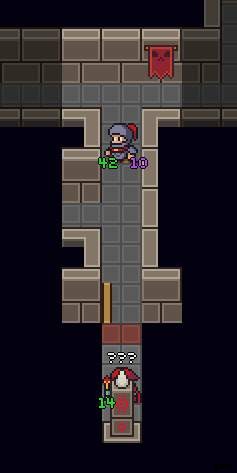
Another example:In this situation after moving east (and the enemy was not in my detection radius before) I got noticed in one turn. So being in LoS on the previous turn was sufficient.
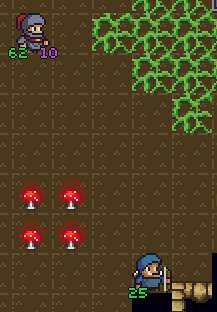
Hearing a Shout
Enemies shout every turn they’re aggroed (as long as they moved or are currently visible), and also have a 50% chance to shout when they die.
Shouts aggro every enemy that is both within 6 tiles of the shout and also within 10.5 tiles of the player (As in, both conditions have to be true.).
Asleep monsters only respond to shouts within 3 tiles (instead of 6). Deep sleep monsters (from Smoke Bomb) don’t respond to shouts at all. Shouts originating more than 7 tiles away from the player have their radius halved from 6 to 3 tiles. (The halvenings from asleep and outside 7 tiles stack.) (Note:It’s>7, not>7.5! So it’s not the same ‘as being in your LoS’. Shouts on the edge of your LoS that aren’t at 7,0 or 6,3 are halved. (Worked example:This sunflower is more than 7 tiles from me, so its shouts are halved to 3 and don’t reach the second enemy.)
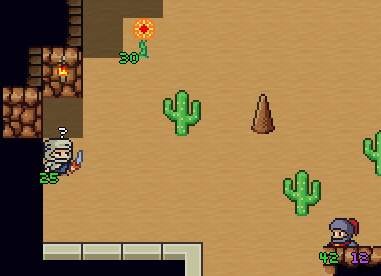
Besides the normal kinds of shout enemies make, there are some other things that are technically a shout:
- Hidden enemies, when they aggro, perform an ‘ambush’ shout that only wake up other hidden enemies within their ambush distance of the player.
- Opening a glyph door performs a ‘strong’ shout that ignores the 10.5 tile limit and ‘radius halvening for being more than 7 tiles from the player’ (In practice I think neither fact matters though.).
Here’s a worked example. I would like to not wake up the unique. So, I should fight the other band of enemies (that definitely will notice me) without letting any of them move onto any of the red dots (where asleep monster would hear a shout within 3 tiles and wake up). If the unique was stationary rather than sleeping I’d have to keep monsters out of a much larger 6 tile radius, but I still could have gone for it.
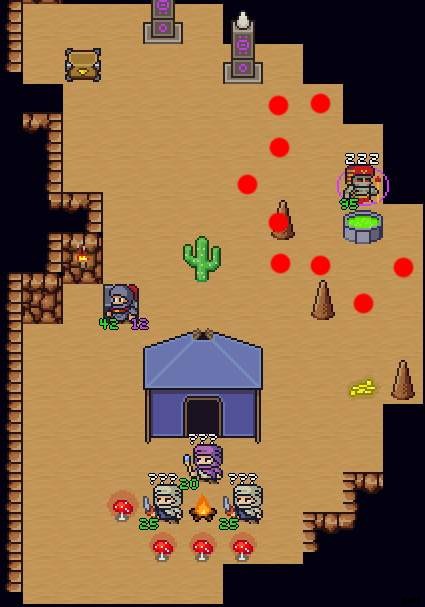
Because enemies only shout 3 tiles if they’re out of LoS, aggroing an enemy and immediately running out of LoS might cause it to not wake up its friends. That 3 tile radius is very small! Plus, it has to be within 10.5 tiles of my new location, too.
Note that enemies only shout when they move to a new tile or if they’re visible (This mostly matters for immobile enemies, which as a result can’t shout if you can’t see them.).
Having and Losing Aggro
Monsters that you’ve aggroed have perfect knowledge of where you are… but the same is true for you! They’ll be visible on the map and minimap unti they deaggro. Even when not in line of sight, they can be shot/targeted (even though the enemy can’t do the same back to you) and the moment they deaggro you can notice this and act accordingly.
unagroTimer goes up by 1 every turn an enemy can’t see you, plus an additional 1 if the enemy is a stationary swimmer or immobile. When it hits 20 turns, the enemy de-aggros. If it can see you, unagroTimer becomes 0 again.
An enemy that deaggros goes back to its previous behaviour – sitting still or wandering.
Some special enemies can never lose aggro once they have it:Grax The Frost Shaman, The Frost Giant King, The Kraken and its Tentacles, Expanderis The Slime King, The Efreeti Lord, Lavosa The Eel Queen.
Advice for Specific Levels
Vault of Yendor – ‘Lava Surround’
This is the floor that looks like this:This is the floor that’s most likely to kill you even with cautious play, because how it works is very spoilery. A common death on this floor looks like this:‘walk to a side, see some skeletons, aggro both fire elementals in the corners, start to get overwhelmed, aggro the rest of the floor, try to take the stairs, die in one turn’. Instead, do the following, which relies on a precise understanding of how aggro works:
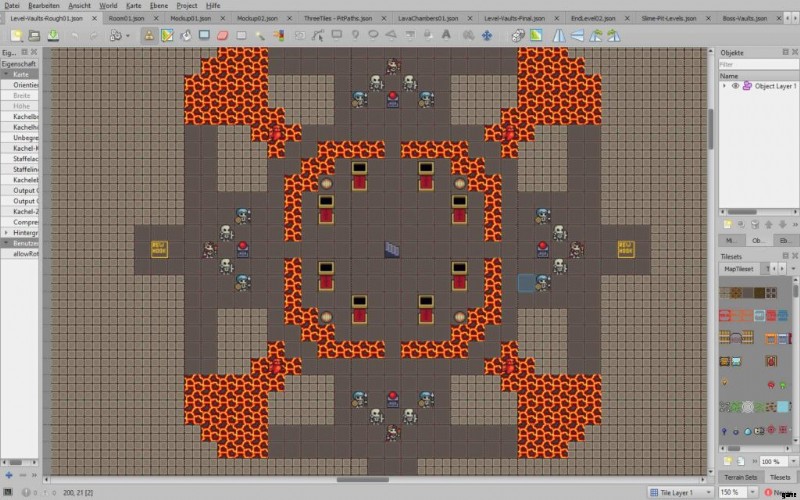 <オール>
<オール> 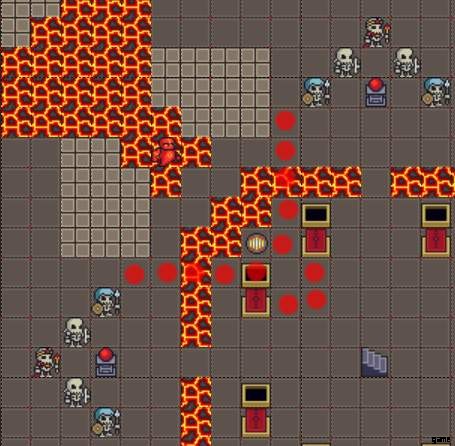
TODO:Random595 has an idea for an alternate strat where you go north, aggro the skeleton pack, SP retreat to a specific point, and you can pick off just the skeletons. But it needs testing before I add it.)
The Kraken
This boss appears at the end of The Sewers branch about 50% of the time. What makes it potentially very difficult is that if you have no ranged options besides fire magic, the fact that it’s wet basically makes it impossible to kill, and you took a one way teleporter to get here. Here are some options you can consider to make the fight easier (or possible):
- Keep your eyes open for a different ranged option. Lightning Bolt is the absolute best, but anything that’s not fire can be passable. Javelins are very good, don’t underrate them.
- If you have Cone of Cold/Wand of Cold and aim it such that all 8 surrounding tiles are frozen, the Kraken can’t move anymore. Then simply never thaw those tiles and you have an easy win.
- If you can’t burst down the head quickly but you can out-range and out-mobility the Kraken, killing the tentacles one by one can work instead. Grab the energy fountain for restoration, use the one-way portals to indefinitely kite, blink and use speed points as needed to retreat and drag things out as long as you can.
- Be aware the tentacles block line of sight for the Kraken’s tentacle attack, and that the tentacles can’t go further than 2 tiles from the Kraken.
- A power potion popped before you start dealing damage will improve your output a lot.
- You don’t have to fight the Kraken now. In fact, you don’t have to fight the Kraken ever. You can go get the other two runes to beat the game.
- If you have a source of blinking, you can blink past the gate and abstain from fighting the boss.

